

Environment
Reduce Industry Footprints with Sustainable Material Swaps
In response to growing consumer demand for environmentally-responsible products and services, corporations across all industries have placed implementing sustainable practices at the top of their agendas.
As of 2021, more than 200 companies have joined the Net-Zero Pledge, an initiative put forth by the Climate Pledge. Launched by retailer behemoth Amazon in 2019, the Climate Pledge challenges corporations to reach net-zero emission by 2040.
In order to reach this goal, companies must reassess their business models. This includes finding sustainable alternatives to commonly-used materials.
Leather
On the surface, animal-derived products like leather seem incompatible with sustainability outcomes. However, leather is one of the most sustainable organic materials used in the fashion and textile industries.
This is because most leathers enter the supply chain by way of the meat industry. When farmers purchase livestock for consumption, the potential profit for selling hides is negligible compared to the profit for selling meat. Thus, leather is a byproduct rather than a driving force of the industry.
Without a market, excess animal hides are burned instead of being repurposed into useful, durable items. Leather’s properties such as water resistance, malleability, and versatility make it ideal for covering items that experience extreme wear and tear. This is why car makers offer models with leather interior options, including Dodge Ram 1500 seat covers, Chrysler steering wheel wraps, and Chevrolet Silverado upholstery.
When cared for properly, high-quality leather products can last more than a century. In this way, leather is far more sustainable than faux options, which last on average less than six years.
Reclaimed Wood and Metal
Opting for recycled building materials is an effective way for the construction and furniture industries to reduce their environmental impact. Industry-recognized sustainability certifications, such as the LEED rating system, also acknowledge the impact of incorporating sustainable and recycled materials into building design and construction.
While lumber’s contribution to deforestation pales in comparison to cattle grazing or agriculture, the logging industry is responsible for 3 percent of the Amazon’s year-over-year decline.
However, logging companies are encouraged to replant felled trees to maintain the industry. Many jurisdictions also enforce reforestation laws that require lumber farmers to replace trees at an outsized ratio.
While wood does have a shelf life, lumber can be repurposed several times before becoming biodegradable waste. Reclaimed wood from old construction projects can be used to create furniture or other buildings.
Although metal lacks the biodegradable quality of wood, it can also be efficiently repurposed. Recycling metal is key to ensuring its sustainability, as mining is a resource-intensive, environmentally-polluting practice. Some of the known impacts include air and water pollution and habitat loss.
Once out of the ground, metals are highly durable. Some types, including steel, iron, and aluminum can be recycled indefinitely. Using reclaimed metal is also economic, as repurposing scrap metal is far cheaper than extracting new sources.
Concrete
Concrete is one of the most common building materials on the planet. The material has several desirable properties, including affordability, flexibility, and durability. Concrete also has the potential to address multiple environmental issues.
Manufacturers are experimenting with the concrete production process to create more ecological materials. For example, green concrete is produced using the byproducts of other industries, thus reducing carbon emissions and water use. Other types of concrete incorporate recycled plastic particles. Not only does this eliminate the need for new materials, but it also removes harmful plastics from the environment.
Concrete design can also affect the environment. The impervious concrete commonly found in parking lots and driveways prevent rainwater from seeping into the ground. This results in flooding risks and makes it more likely for rainwater to collect pollutants.
Pervious concrete contains small channels that allow water to pass through. These channels also reduce the amount of heat absorbed by the pavement, which lowers a harmful phenomenon known as the “heat island effect”. Pervious concrete enables cities to moderate high temperatures more efficiently, reducing reliance on energy-consuming cooling methods.
Cardboard
Cardboard packaging and liners are ubiquitous across industries from logistics to your local coffee shop looking to reduce waste. As new cardboard production requires raw wood pulp, recycling and repurposing existing material is far more sustainable. Recycling firms can clean and break down cardboard packaging to create paper. These sheets can be bonded together to make new packaging.
Many industries are actively replacing single-use plastics with cardboard. For example, many food distributors have swapped toxic styrofoam trays for cardboard. Large corporations such as McDonald’s and Starbucks have completely eliminated plastic straws in favor of sturdy cardboard straws.
Cardboard is also biodegradable and can introduce carbon into compost. Most forms of cardboard fully decompose within 8 weeks. Gardeners can hasten the process by breaking up the cardboard into thin strips.


 Environment10 months ago
Environment10 months agoAre Polymer Banknotes: an Eco-Friendly Trend or a Groundswell?

 Environment11 months ago
Environment11 months agoEco-Friendly Home Improvements: Top 7 Upgrades for 2025

 Features9 months ago
Features9 months agoEco-Friendly Cryptocurrencies: Sustainable Investment Choices

 Features10 months ago
Features10 months agoEco-Friendly Crypto Traders Must Find the Right Exchange

















